On test: 3 types of shade for outdoor pigs
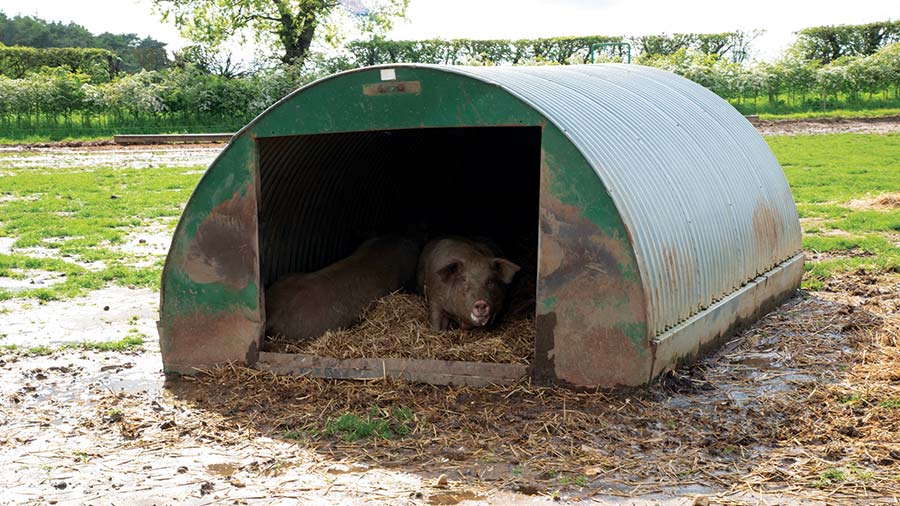 © MAG/Martin Ward
© MAG/Martin Ward A Norfolk outdoor pig unit is trialling three ways of providing shade to find out which one offers the most practical solution to improving pig welfare and productivity.
Digging wallows has become common practice during the summer months, enabling pigs to cool off and cover themselves in wet mud to protect their sensitive skin from the sun.
But maintaining wallows is a time-consuming business, says manager at LSB Pigs, Rob McGregor.
See also: 7 ways to minimise heat stress in outdoor pigs
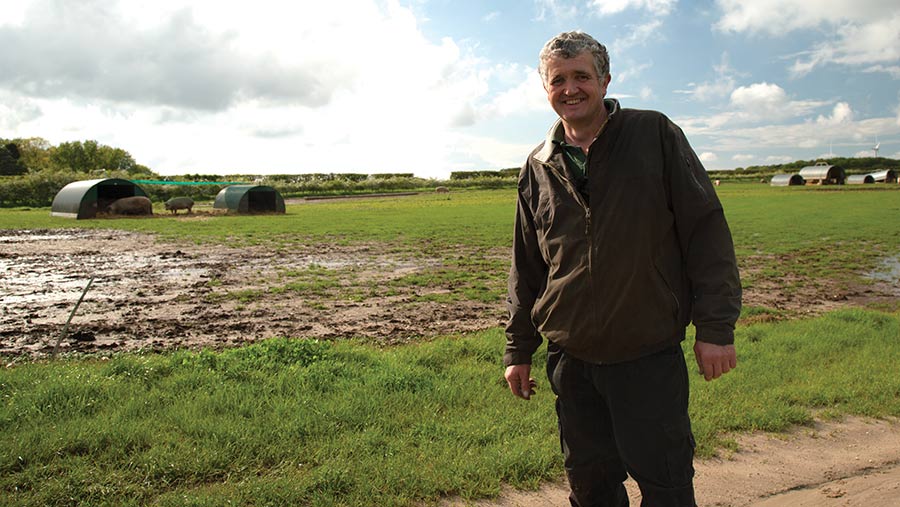
Rob McGregor © MAG/Martin Ward
“Here, it’s almost a full-time job for one person and uses 60,000 litres of water a day.
“We can’t get away from wallows, but if shades can take some of the strain, we might not have to start digging the wallows so early in the season – or they might not need to be so big.”
Farm facts: LSB Pigs, Norfolk
- 900-sow unit
- Landrace-cross-Duroc sows and Duroc boars
- First service to artificial insemination; natural service to pick up any returns
- Farrowing batches every two weeks
- Five-week weaning
- Pure Landrace herd for breeding own replacement gilts
Practical challenges
The rotational nature of an outdoor pig system, usually as part of an arable rotation, means permanent structures are not always practicable.
In addition, structures and materials must be sturdy enough to stay in place in strong winds and/or withstand contact with pigs.
In the past, Rob, who manages a 900-sow unit near Fakenham, has tried stringing up shades between farrowing huts and vertical wooden posts.
However, he found older-style huts, made to a basic timber and metal design, were not grounded enough to stop them shifting, especially when sows rubbed up against the doorways, and the shades would sag.
He has also experimented with marquee-like tents, which provided shade for groups of 40 dry sows. But these were hard work to move and expensive to maintain.
They could easily rip on a windy night, and it would cost a minimum of £500 to replace the damaged part.
New opportunities
Now, in the farrowing area, following considerable investment, sows have huts made with a double thickness of refrigeration-grade insulation foam. This keeps them cooler in summer as well as warmer in winter.
Together with good, adjustable ventilation, this environment encourages the sows to stay with their piglets – although they also have individual wallows for cooling off outdoors.
While the dry sows do not have insulated huts, improvements in hut design bring a new opportunity to provide shade for them more effectively.
The dry sow huts at Rob’s unit are now bigger, making them heavier and more stable. They are also taller, so a shade can be slung between two huts without needing a frame for attachment.
“We will have these metal huts for 10 years, because of the investment in them, so in providing shade, we are trying to make the best of what we have,” says Rob.
The metal huts have a doorway at the front and one at the back. During winter, the back door is kept closed; in the summer, it is opened to create a through-draught.
It takes Rob’s team two weeks to switch the unit to “summer mode”, and once the back doors have been opened, there is not time to make further adjustments.
It is a gamble to choose which day to open them, says Rob – too early, and the sows have insufficient shelter on cold nights in late spring; too late, and they might become heat stressed.
Providing some form of shade for the first few sunny days before committing to opening the backs of the huts would offer a happy medium.
Option 1: Plastic mesh shade
Rob is repurposing a windbreak produced by farm equipment specialist Silostop as a shade in the service area of the unit. Here, sows spend eight weeks in paddocks of 18.
In each paddock, there are two huts facing in the same direction, with their sides to the prevailing westerly wind.
The 6x4m shade is made of plastic mesh that does not fray or ladder. It is fixed across the space between the two huts, through which a breeze is drawn by a wind-tunnel effect.
It is attached by ratchet straps to metal loops at each end of the huts (already in place to allow for the hut to be moved using a forklift) and the tension adjusted as needed.
Rob has calculated the cost of the mesh at £10 a sow place, or £180 for an 18-sow paddock. He expects it to last at least two to three years.
Early verdict: The sows have been making good use of the shade it provides. “If it shows some improvement [in providing shade], then it’s worth it,” he says.
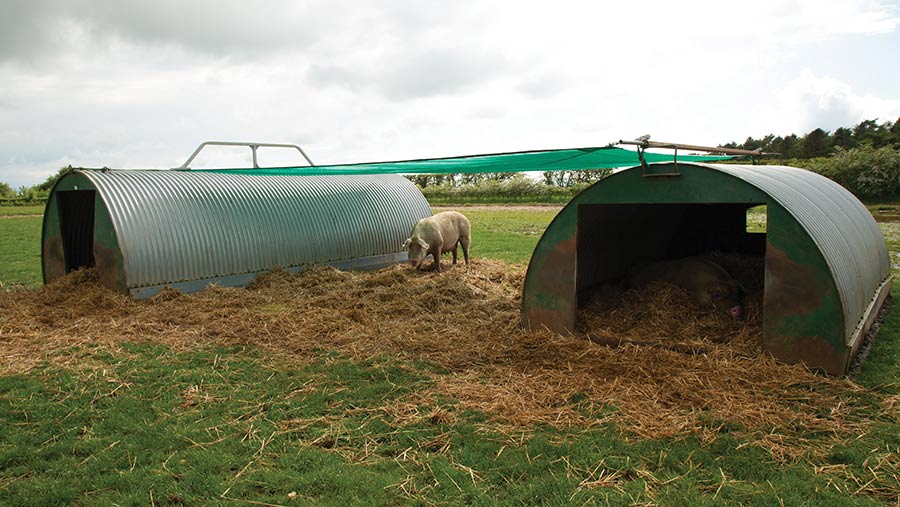
© MAG/Martin Ward
Option 2: ‘Gazebo’
Rob is also trialling a “gazebo” shade that does not require any additional equipment. Instead, the larger of the two huts is lifted onto four 500-litre redundant water tanks, filled with earth to ballast them, and secured with straps.
The raised hut provides the shade under and beyond it and produces a good airflow.
“We tried something similar about 20 years ago, where we sat a hut on two Hesston bales, but the sows would start to attack the bales,” he says. “This method is more affordable – we don’t have the straw to throw at it – and safer.”
For the trial, this method of shade was set up in late April, at the same time as the plastic mesh. In practice, mid-July would be more appropriate, he says, adding: “If the weather was poor [before this time], it would not be an acceptable form of protection.”
Early verdict: “There’s more airflow under the gazebos, certainly, and the sows are very willing to congregate under them, but we couldn’t suddenly set them up. At this stage, I would go for the [plastic mesh] shade over this.”
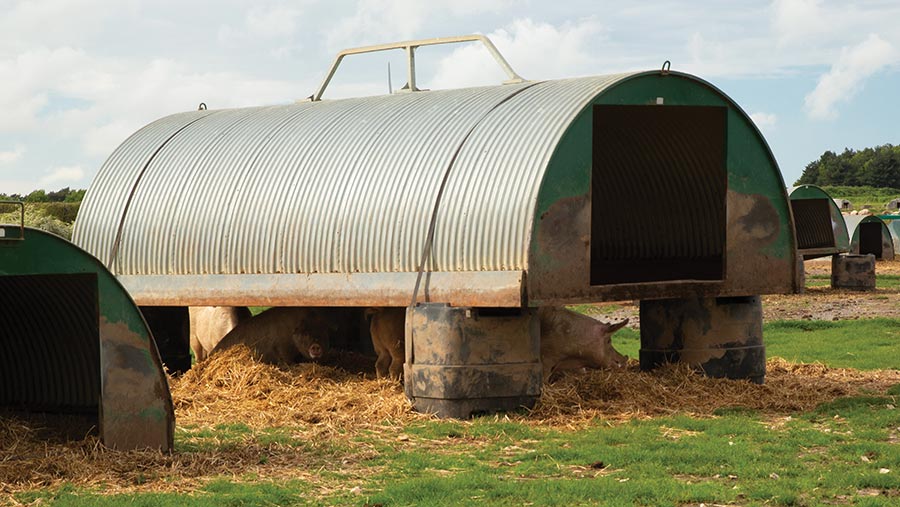
© MAG/Martin Ward
Option 3: ‘Half-gazebo’
Rob is also trialling a “half-gazebo”. This involves raising the hut at the front only to provide more shelter than the fully raised hut and more airflow than the huts sited fully on the ground.
Early verdict: Some sows have been confused by the varying height of the half-gazebo, and it has not been used as much as the fully raised one. In addition, aesthetically, it is “odd”, says Rob.
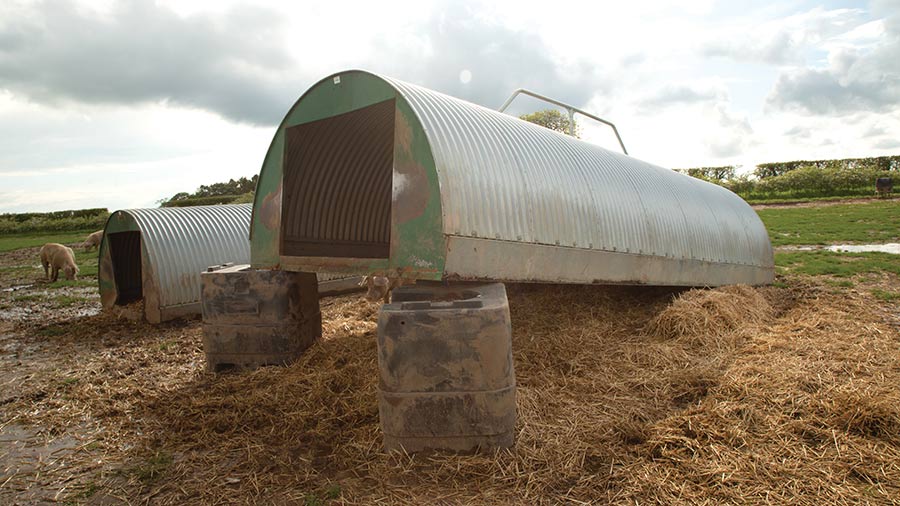
© MAG/Martin Ward
Results after two months
Two months into the trial, Rob says the sows are making good use of all the areas provided.
“In the heat of the day, I’m seeing four or five sows using the wallow and the rest – if not drinking or grazing – are spacing themselves out under the mesh shades, or in the huts, which are [now] open both ends to keep the inside as cool as possible.
“Previously, the wallow would be busier, and more sows would be competing for the limited patches of shade they could find around the outside of the huts.
“Some would be lying in the sun and those inside the huts would be closer together and undoubtedly hotter as a result.
“The mesh shade is definitely the most practical option on our site.”
Heat stress in boars
Providing shade is important for boars as well as sows, says Rob McGregor of LSB Pigs. Boars are notoriously susceptible to heat stress.
At the outdoor pig unit he manages, boars are kept with sows during the first six weeks of pregnancy to pick up any returns. Hot summer temperatures impact their fertility, but up to 10 weeks pass before the effect is seen.
“Units generally struggle with fertility in the autumn,” he says.
“This is put down to a seasonality effect – a September or October pregnancy means producing a litter in the middle of winter – but it’s also because a boar heat-stressed in August means poor-quality semen a few weeks later.”
